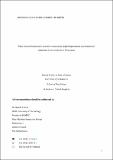Files in this item
What visual information is used for stereoscopic depth displacement discrimination?
Item metadata
| dc.contributor.author | Nefs, Harold | |
| dc.contributor.author | Harris, Julie | |
| dc.date.accessioned | 2012-06-12T14:01:01Z | |
| dc.date.available | 2012-06-12T14:01:01Z | |
| dc.date.issued | 2010 | |
| dc.identifier | 5286037 | |
| dc.identifier | c6e45681-764b-4c4a-b574-24dd651681fa | |
| dc.identifier | 77954811759 | |
| dc.identifier.citation | Nefs , H & Harris , J 2010 , ' What visual information is used for stereoscopic depth displacement discrimination? ' , Perception , vol. 39 , no. 6 , pp. 727-744 . https://doi.org/10.1068/p6284 | en |
| dc.identifier.issn | 0301-0066 | |
| dc.identifier.other | ORCID: /0000-0002-3497-4503/work/46085843 | |
| dc.identifier.uri | https://hdl.handle.net/10023/2746 | |
| dc.description.abstract | There are two ways to detect a displacement in stereoscopic depth, namely by monitoring the change in disparity over time (CDOT) or by monitoring the inter-ocular velocity difference (IOVD). Though previous studies have attempted to understand which cue is most significant for the visual system, none have designed stimuli that provide a comparison in terms of relative efficiency between them. Here we used two-frame motion and random dot noise to deliver equivalent strengths of CDOT and IOVD information to the visual system. Using three kinds of random dot stimuli, we were able to isolate CDOT or IOVD or deliver both simultaneously. The proportion of dots delivering CDOT or IOVD signals could be varied, and we defined discrimination threshold as the proportion needed to detect the direction of displacement (towards or away)1. Thresholds were similar for stimuli containing CDOT only, and containing both CDOT and IOVD, but only one participant was able to consistently perceive the displacement for stimuli containing only IOVD. We also investigated the effect of disparity pedestals on discrimination. Performance was best when the displacement crossed the reference plane, but was not significantly different for stimuli containing CDOT only, or containing both CDOT and IOVD. When stimuli are specifically designed to provide equivalent two-frame motion or disparity-change, few participants can reliably detect displacement when IOVD is the only cue. This challenges the notion that IOVD is involved in the discrimination of direction of displacement in two-frame motion displays. | |
| dc.format.extent | 2722722 | |
| dc.language.iso | eng | |
| dc.relation.ispartof | Perception | en |
| dc.rights | The definitive, peer-reviewed and edited version of this article is published in Perception 39(6) 727-744. doi:10.1068/p6284 Copyright (c) Pion, 2010. | en |
| dc.subject | BF Psychology | en |
| dc.subject.lcc | BF | en |
| dc.title | What visual information is used for stereoscopic depth displacement discrimination? | en |
| dc.type | Journal article | en |
| dc.contributor.sponsor | EPSRC | en |
| dc.contributor.institution | University of St Andrews.School of Psychology and Neuroscience | en |
| dc.contributor.institution | University of St Andrews.Institute of Behavioural and Neural Sciences | en |
| dc.identifier.doi | 10.1068/p6284 | |
| dc.description.status | Peer reviewed | en |
| dc.identifier.grantnumber | EP/D002281/1 | en |
This item appears in the following Collection(s)
Items in the St Andrews Research Repository are protected by copyright, with all rights reserved, unless otherwise indicated.

